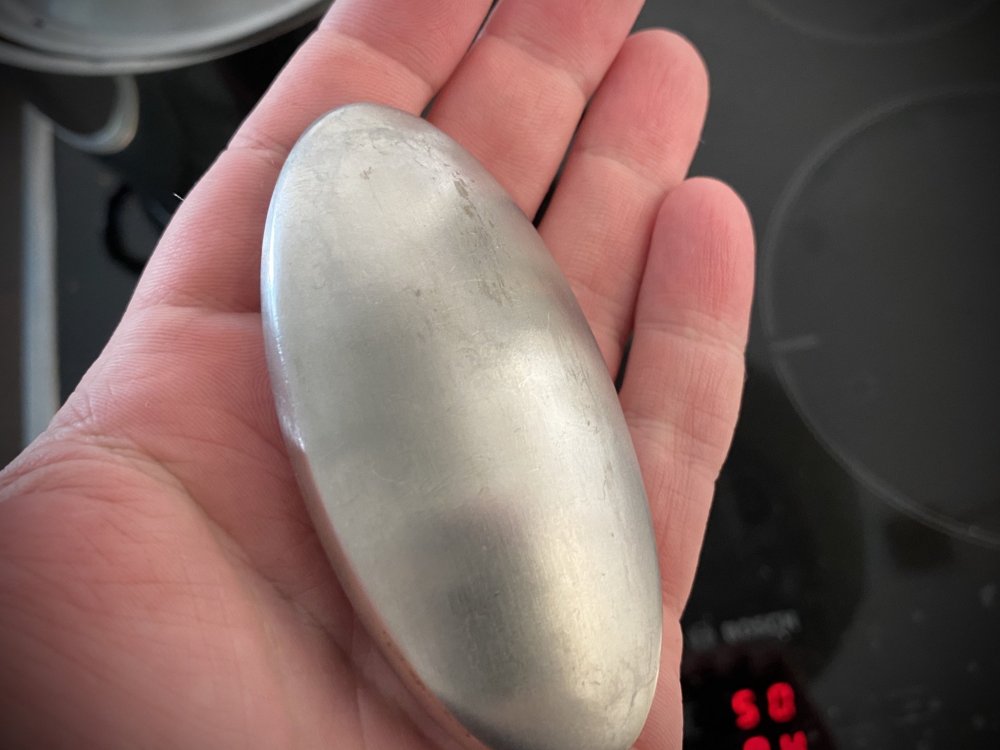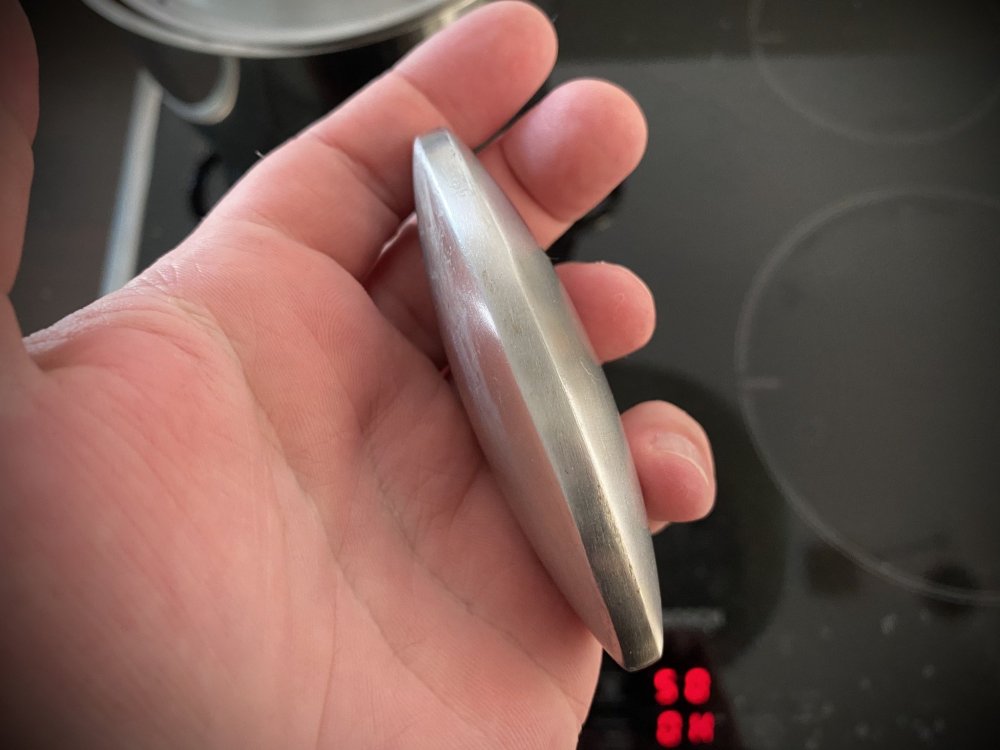Leaderboard
Popular Content
Showing content with the highest reputation on 09/16/20 in all areas
-
The cleaning begins with a natural chemical reaction called oxidation-reduction discovered by a Dutch gardener. He used his steel planting tool to remove the stubborn leek odors from his hands. When in contact with water, the metal ions in stainless steel capture and penetrate the sulfur and nitrogen molecules responsible for the foul fumes. So, on first contact with steel, the smell of foods rich in sulfur disappears immediately. An oxidation-reduction (redox) reaction is a type of chemical reaction that involves a transfer of electrons between two species. An oxidation-reduction reaction is any chemical reaction in which the oxidation number of a molecule, atom, or ion changes by gaining or losing an electron.2 points
-
Okay so I got this „bar of soap” made of stainless steel (I think) I’ve had it for years and I have no idea where I have it from, probably someone gave it to me as a present 15 or 20 years ago. The purpose of this thing (I remember that) is to get rid of garlic/onion scent from your hands by washing in cold water and this bar of steel soap. The thing is that this actually works and I want to know exactly why? I’ve tried every combination of washing with/without it and always the steel soap wins, it clearly does what its supposed to do. Why is it that steel (and cold water) helps in getting rid of scents from your hands? The Bolognese will be ready in about 1 hour by the way.1 point
-
I must say this comment is making me think a lot. Political movements don't just pop up by spontaneous generation. They capitalize on some previous climate of opinion, discontent, etc. For some reason a fundamental disconnect between science and some sectors of the general public has grown, and I would like to understand the roots of that. Maybe such a connection didn't exist in the first place, and people who are trying to turn to science in search of answers are easily disappointed, maybe because of the very simple fact that opinion is not enough, and they don't expect that. I saw a cartoon the other day suggesting that it's to do with science and scientists sounding arrogant in the ears of big swathes of the public. I'm not so sure about that, but there seems to be a communication gap. Creepy!1 point
-
High nitrogen martensitic stainless steels show improved resistance to localized pitting. Corrosion & Resistance of Stainless steel : https://en.wikipedia.org/wiki/Stainless_steel#Corrosion_resistance1 point
-
1 point
-
Thanks Kartazion, I didn’t realize that rust, burning fuel and getting rid of garlic scent from my fingers after making BEST BOLOGNESE around are the same group of reactions.1 point
-
I think it is wrong to narrowly focus on the Trump administration. It is merely the result of at least decades of anti-science sentiments. One of the main topics used to be creationism which got a strong push into the open in the 2000s (incidentally one of the reasons why I joined this forum). The movement started well before that, though and was an alliance of industrial interests, conservative leadership and media. In essence it was a broader effort to undermine the very concept of scientific validity and thereby allowing politicians to act without the constraints of reality. Key efforts were obviously put on areas with monetary interest, such as climate change denial and over time it morphed into a weird form of conservative identity. Originally a bit fringy, over time it it became the mainstream we see today. This is not exclusive to the US, even in other Western countries, such as Canada, and Australia similar political efforts were made to silence scientists involved in climate change research. However, the cultural identification with denial seems to be an US export.1 point
-
1 point
-
The reaction has to be extremely miniscule, I've had this steel bar for around 2 decades and it doesn't change its shape or color in any way like stainless steel normaly does in a household environment. Oh no you didn't. No one makes fun of my Bolognese. No one. Do you have a source? Sounds like a grat explanation.1 point
-
I don't believe it for one minute ! Not the part about the steel bar of soap, but a Polish guy making Bolognese sauce.1 point
-
I think the scientific general consensus is that Sweatman is smart enough to be able to develop excellent pseudoscientific theories which he turns into best sellers. For the layman his ideas seem sound, but to the scientist who actually studies what Sweatman is writing about it is all nonsense. Sweatman develops a plausible scenario (I purposely did not use the word "theory") but is not interested in investigating any of the obvious next steps to support his conjectures. He's not a scientist in these cases; he's a writer. Therefore once the book is done, from his perspective there is nothing left to do. Sweatman is similar to Asimov in that he uses his scientific knowledge to be able to write believable fiction.1 point
-
Sorry Koti. I wish Venus was like it was depicted in 1930s pulp sci-fi also. ( Edgar Rice Burroughs novels ) PH3 is a strong reducer ( stronger than ammonia ) and readily oxidized ( actually burns ) to Phosphorus Pentoxide, or to Phosphoric acid if water is present , so it doesn't last long. Since the Venusian atmosphere is strongly acidic, the other method for producing large amounts of Phosphine ( if actual, much higher than in Earth's atmosphere where it is due to bio-decay ), by reaction of white Phosphorus with Sodium/Potassium Hydroxide, is probably a non--starter. Thanks for the link, Area541 point
-
Based on that explanation, quite hard. The authors note "Solid surfaces of rocky planets present a barrier to their interiors, and PH3 would be rapidly destroyed in their highly oxidized crusts and atmospheres." In a paper by Sousa-Silva et al the mechanisms for the destruction of PH3 are discussed in section 2.3. For that matter, if I am understanding the discussions correctly, even in environments where PH3 is generated (the atmospheres of giant planets) it is also destroyed , there being a temperature dependent chemical equilibrium. Thus Jupiter's upper atmosphere hosts concentrations of phosphene above the equiibrium level because of ongoing convective resupply from deeper hotter levels. Note: Through, presumably "operator error", the link to the original paper on the subject I thought I had placed in my first post (third in the thread) is not working. This one will work. @swansont Would it be possible to correct the link in my first post? Thanks.1 point
-
The smelly culprit is sulphur-based and that, apparently, forms an acid with water, which reacts with some component in the metal bar. My guess is iron into its sulphate.1 point
-
It assumes that you have both liquid water and air with water vapor. And it means that equilibrium has been reached and as much water is evaporating from the liquid phase as water from the air is condensating. So the air has as much water as it can have at that pressure and temperature. Thereby the "saturated" word. So the key is: above that pressure, water from the air would condense. I hope that helps and I didn't make any mistake --it's been a while and I'm a bit busy with other matters so I'm making mistakes lately.1 point
-
Stop putting houses in the middle of fire prone areas. No different than not putting houses in flood plains.1 point
-
Sorry guys it took so long to respond but life happened. I live in the USA. I am working on self employment goals at the moment.1 point
-
Get rid of Vit E. That is absolutely unnecessary as part of a sanitizer. It’s added in tiny amounts in commercial products for marketing purposes, but it really has no effect in a sanitizer. If you really want to keep it: Phase A Water, Glycerine, Isopropyl Alcohol Phase B Decyl Glucoside, Tocopherols (mix very very well) Phase C Preservatives and Fragrance NOTE: For alcohol to be effective you need to use over 60% by volume in your formulation. At this level you don’t need other preservatives. Procedure: mix phase B into phase A until combined and homogenous. Then add preservatives and fragrance one by one and stir until combined before adding the next.1 point
-
If you have enough material, you could try in a small "sample" solving the Vitamin E in glycerine first, then add the emulsifier and add the water phase in small portions while stirring. This is just an idea from me personally, as Vitamin E is known to be lipid soluble. Keep me updated, whether you try it and if it works.1 point
-
It is important here not to confuse what someone visually sees happening to a clock approaching or receding with how fast that clock is actually ticking according to that person. In the first case you have to account for the Doppler effect which is caused by the decreasing or increasing distance between you and the clock. This would happen even if the clock itself did not tick any faster or slower than your own. Time dilation of the clock is a measure of how fast the clock is actually ticking compared to your own, and this is independent of its direction of movement. When you are watching a clock approaching or receding, what you visually see is a combination of these two effects. The math for what you will see is [math]f_o = f_s \sqrt{\frac{1-\frac{v}{c}}{1+ \frac{v}{c}}}[/math] Where f0 is the observed tick rate. fs is the source tick rate v is the velocity of the clock relative to you(positive if receding and negative if approaching) c is the speed of light. So let's work out a couple of examples: Assume you are situated 1 light hr from a stationary(to you) clock that is synchronized to your own clock (when your clock reads 12:00, it reads 12:00) You looking at this clock when your clock reads 12:00 will visual see the clock as reading 11:00. (since it took the light carrying that image 1 hr to travel from the other clock, to get to you when your clock reads 12:00, it had to leave the other clock when it read 11:00) A third clock travels from your position to the second clock at 0.8c Using the formula above we find that you will see it tick 1/3 as fast as your own. It will arrive at the second clock in 1.25 hrs when the second clock reads 01:15. But because of the light travel time lag between you and the second clock, you will not see this until until your clock reads 02:15. This means the you will watch the third clock recede for 2.25 hrs by your clock while seeing it ticking 1/3 as fast and thus if it read 12:00 when it left you, you will see it arriving at the second clock reading 12:45. So in the 1:15 it took to make the trip it only ticked off 45 min. (remember, even though you didn't see the third clock arrive until your clock read 02:15, it had actually arrived an hour earlier.) Now let's do a reverse trip. you see the second clock read 01:15 and the third clock reads 12:45 when your clock reads 02:15, however this image of those two clocks left 1 hr ago, so the third clock left the second clock when your clock read 01:15 (in other words, if the third clock turns around and heads back the moment it reaches the second clock, by the time you see this, the third clock is already well along its trip back to you.). The return trip takes the same 1.25 hrs, which means it arrive back at you when your clock reads 02:30. This means that you will see its entire return trip occur during the 15 min between 02:15 and 02:30. At a accelerated tick rate of 3 you will see the third clock tick off 45 min during that period, and read 01:30 upon arrival, when your clock reads 02:30. So again, it ticked off 45 min during the 1.25 hr trip, the same as for the outbound trip and accumulated at total of 1.5 hrs for your 2.5 hrs. The direction had no effect on the time dilation or total accumulated time difference even though it did have an effect on what you visually saw happening to the clock.1 point
-
Dark matter and dark energy are most likely non local cosmological phenomena that arise because our current scientific method cannot conceive anything (balancing energy/mass) existing outside of the big bang/CMBR bubble and as a result looks solely for a solution inside that bubble while our local conception of the Milky Way and other galaxies don't have that restriction. This appears in the difference between the virial overdensity constant, Δc, in the universal ΛCDM model and that typically assumed locally for galaxies. https://en.wikipedia.org/wiki/Virial_mass#Virial_radius-2 points












